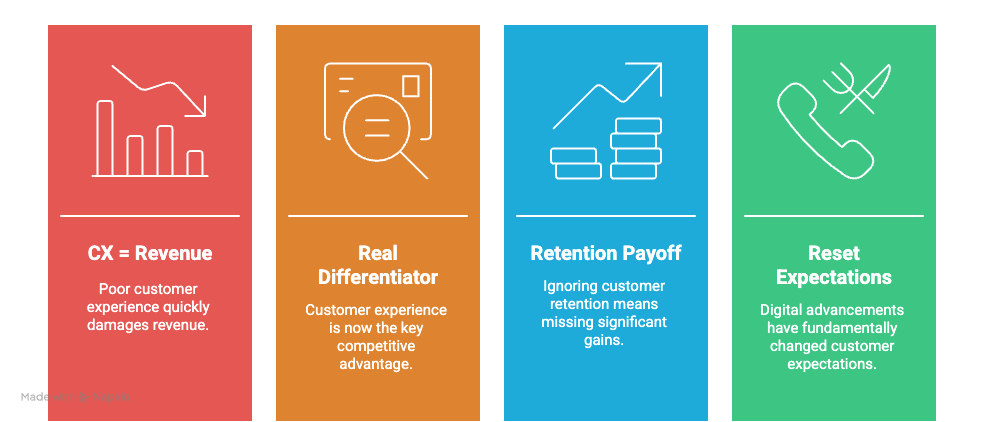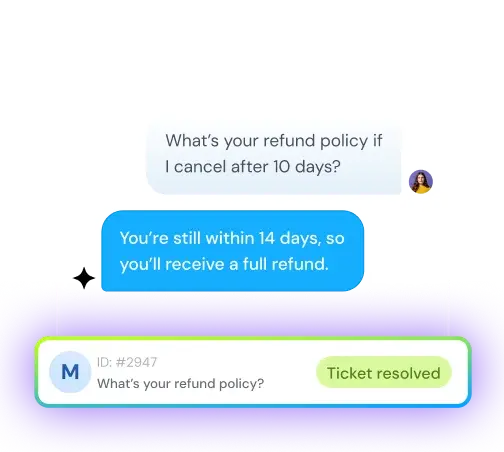45 key customer experience statistics that truly matter to your business
Sneha Arunachalam
Nov 18, 2025

In today's hyper-competitive marketplace, customer experience (CX) has emerged as the ultimate differentiator between thriving businesses and those struggling to survive.
Understanding customer experience statistics isn't just about tracking numbers; it's about unlocking the strategic customer experience insights that drive business growth, enhance customer satisfaction, and build lasting brand loyalty. Whether you're a startup founder, marketing executive, or customer success leader, the data presented in this comprehensive blog will equip you with the knowledge needed to transform your CX strategy and deliver experiences that truly matter.
45 customer experience statistics every business should know
CX impact on revenue and growth
1. Of companies that focus on CX, there's an 80 percent increase in revenue - Zippia
2. Brands that deliver the best CXs report 7 times more revenue than their competitors that lag in such efforts - Forrester
3. CX leaders grew revenues 4 to 8% above their markets - Bain & Company
4. Companies with improved CXs reported 84% revenue uplift - Dimension Data
5.84% of businesses enhancing CX experience increased revenue - Forrester
6. Companies with a strong CX strategy see 1.5x higher revenue growth than those without - Forrester
7. Improving CX by just one point can increase revenue by $1 billion for a large company - Forrester
8. Customers are willing to pay a 16% premium for great experiences—especially in B2B and service categories - PwC
9. A significant 61% of consumers are ready to spend at least 5% extra if they know they'll receive a good customer experience - PwC
10. 41 percent of customer-obsessed companies achieved at least 10 percent revenue growth in their last fiscal year, compared to just 10 percent of less mature companies - Forrester
Customer loyalty and retention statistics
11. Research shows that increasing customer retention rates by just 5% can boost profits by up to 95% - Bain & Company
12. Loyalty leaders—companies at the top of their industries in Net Promoter Scores or satisfaction rankings for three or more years—grow 2.5 times faster than their competitors - Bain & Company
13. 50% of existing customers are likelier to try new products and 31% spend more than new customers - BIA Advisory
14.92% higher customer loyalty in companies with improved customer experiences - Dimension Data
15. Customers with favorable past experiences spent 140% more than customers with negative experiences - Temkin Group
16. A 5% increase in customer retention volume could drive profits up to 75% - Bain & Company
17. A small increase in brand loyalty (7%) can translate to a customer lifetime value (CLV) of up to 85% or greater - Motista
18. 96% of customers say customer service is important in their choice of loyalty to a brand - Microsoft
19. Companies that excel at CX have customers who are 7x more likely to buy more from them - Temkin Group
20. 86% of customers are more likely to remain loyal to businesses that invest in onboarding content that educates and welcomes them post-purchase - Wyzowl
The cost of poor customer experience
21. 73% of customers will switch to a competitor after multiple bad interactions, and more than half will leave after just one - Zendesk
22. 70% will abandon a brand after just two bad experiences - Emplifi
23. 72% of consumers switch brands after three or fewer poor service interactions - Qualtrics
24. According to PwC, 1 in 3 customers will leave a brand they love after just one bad experience, while 92% would completely abandon a company after two or three negative interactions - PwC
25. 53% say being kept on hold is reason enough to give up on a company - American Express
26. 54% cite having to repeat their issue multiple times as a reason for leaving a brand - Accenture
27. 89% of eCommerce consumers quickly stopped buying at stores that offered poor customer service - RightNow
28. 86% of consumers would leave a brand after as few as two poor experiences - Emplifi
29. 49% of consumers have left a brand in the past year due to poor customer experience - Emplifi
30. 60% of customers would stop doing business with a brand if the service wasn't friendly - PwC
Personalization and customer expectations
31. 66 percent of consumers say they will share personal data about themselves if they think it will elevate their customer experience - Redpoint Global
32. 62 percent of consumers agree that personalized recommendations are better than general ones - Zendesk
33. 80% of customers are more likely to purchase from a brand that offers personalized experiences - Epsilon
34. 66% of customers say they will stop supporting a brand if their experience isn't personalized - Segment
35. 65% of consumers expect tailored experiences, and 80% are more likely to make purchases from brands that deliver personalized interactions - Salesforce
36. 71% of brands that invest in personalization see improved customer loyalty - Forrester
37. Personalized emails deliver 6x higher transaction rates than non-personalized emails - Experian
38. Companies that grow faster drive 40 percent more of their revenue from personalization than their slower-growing counterparts - McKinsey & Company
Investment and strategic priorities
39. A significant 80% of companies plan to increase their investment in customer experience - Gartner
40. 80 percent of leaders plan to increase customer service budgets over the next year - Zendesk
41. 45% of enterprises say improving customer experience is a top-three initiative - Dimension Data
42. 74% of organizations are increasing their CX investments - Gartner
43. 90 percent of businesses, regardless of the vertical they are operating in, have stated that they have made CX their primary focus - Forrester
44. Almost half of the industry is prioritizing personalization and customer insights in their CX investments for 2025 - Forrester
45. 43% of companies are investing in AI, chatbots, and automation to improve speed and scalability in support - Salesforce
Why customer experience statistics matter more than ever

If you look around, it’s obvious that people expect more from businesses today. Faster responses. Less friction. More clarity. Basically: “Don’t make me work too hard.” And this isn’t just a feeling — 90% of CX leaders say customer expectations are higher than they’ve ever been.
That alone explains why customer experience has gone from “important” to “if you ignore this, you’re in trouble.” CX stats aren’t just data points anymore. They’re warning signs. Signals. Clues about what customers will tolerate — and what pushes them away.
CX = Revenue
There’s always one question people ask when talking about customer experience:
“Okay, but does it really make us money?”
Short answer: yes.
Long answer: a lot.
- Companies that prioritize CX grow 80% faster.
- Customer-focused brands earn 60% more profit.
- And the average ROI on CX programs is 356%.
You don’t usually see returns like this anywhere else in business.
If CX were a stock, every investor would be buying it.
When CX goes wrong, it hurts much faster
Good customer experience makes you money.
Bad experience drains you — instantly.
Here’s the uncomfortable part:
- 1 bad experience = 50% of customers walk away.
- 2 bad experiences = 70% leave.
- And most people don’t even tell you there was an issue — only 1 in 26 complain.
The rest just disappear quietly.
By the time you notice fewer repeat customers or slowing revenue, the damage is already done.
CX has become the real differentiator
Products can be copied. Features will be copied. Pricing can be matched overnight.
But the feeling a company gives you?
That’s much harder to duplicate.
Customers say CX now influences buying decisions almost as much as price or product — 73% of them. And 89% of companies admit that they’re competing on experience more than anything else.
In simple terms:
Good experience = you survive.
Great experience = you lead.
The retention payoff is too big to ignore
Everyone loves talking about acquisition, but retention is where the real math gets interesting.
- Keeping customers is 5× cheaper than acquiring new ones
- A 5% increase in retention can boost profits by up to 95%
And loyal customers behave differently:
- They buy more
- They forgive more
- They refer more
- They try new things sooner
It’s like having a multiplier on your growth — but only if you take care of the people you already have.
Digital has completely reset expectations
People don’t compare your brand to your competitors.
They compare you to the best digital experience they’ve had anywhere — Amazon, Apple, Netflix… whoever got it right last.
A huge part of this comes down to mobile, which now owns over 61% of global usage.
If your mobile site is clunky, slow, or confusing, customers won’t wait for you to fix it.
They just leave and assume someone else does it better.
How to use these customer experience insights

1. Get everyone in the company on the same CX page
If leadership doesn’t care, no one else will.
If teams don’t share info, customers feel it.
If feedback stays buried, problems stay hidden.
CX becomes real only when it becomes everyone’s responsibility.
2. Invest in tools that reduce friction — not add it
Not every platform is worth it.
But the ones that matter are the ones that:
- Give a full view of the customer
- Let conversations flow across channels
- Help agents work faster
- Make mobile a priority
- Measure things that actually matter (NPS, CSAT, CES, churn)
If a tool doesn’t fix something painful, skip it.
3. Personalize, because generic is dead
People want to feel known — not processed.
If you can remember their history, their preferences, and what they’re trying to do, the whole experience improves instantly.
4. Fix onboarding, retention, and follow-ups
Most churn doesn’t happen because of price or features.
It happens because customers didn’t get value fast enough.
Good onboarding + proactive check-ins = fewer unhappy surprises.
5. Be faster — even if “fast” means automated
Customers don’t mind bots.
They mind waiting.
A quick automated response beats a 7-hour wait every single time.
6. Make channel-switching seamless
Customers don’t care that your email team is different from your chat team.
They just want to pick up the conversation where they left off.
7. Collect feedback — then prove you listened
People will forgive mistakes if they see you trying.
They won’t forgive being ignored.
8. Track fewer metrics — but track the right ones
Choose the ones that show real health:
- NPS
- CSAT
- CES
- Churn
- Response time
- First contact resolution
- CLV
Everything else is noise.
9. Support your frontline team
Your agents are your experience.
If they’re overwhelmed, understaffed, or working with broken systems, customers will notice instantly.
10. Use AI thoughtfully
AI is great for repetitive questions, routing, summaries, and FAQs.
But the handoff to a human must feel natural, not abrupt.
Customer experience statistics: Table at a glance
Category | Key Statistic | Business Impact |
Revenue Growth | CX leaders grow 80% faster than competitors | Direct correlation between CX excellence and revenue acceleration |
ROI on CX Investment | 356% median ROI on CX programs | Every dollar invested returns $3.56 in additional revenue |
Retention Power | 5% retention increase = up to 95% profit increase | Retention is the highest-leverage growth strategy |
Acquisition vs. Retention Cost | 5x more expensive to acquire than retain | Massive cost savings from focusing on existing customers |
Customer Switching | 50%+ switch after one bad experience | Zero tolerance for poor experiences in 2025 |
Personalization Impact | 80% more likely to buy with personalization | Personalization is now baseline expectation, not differentiator |
Mobile Commerce | 61.59% of global market share | Mobile optimization is non-negotiable for success |
Budget Increases | 80% of companies increasing CX investment | Industry-wide recognition of CX as strategic priority |
Loyalty Multiplier | Loyal customers 5x more likely to repurchase | Retention creates compound growth through repeat business |
Speed Expectations | 90% want immediate responses | Speed has become critical component of satisfaction |
Personalization Premium | Customers pay 16% more for better CX | Great experiences justify premium pricing |
Complaint Reality | Only 1 in 26 unhappy customers complain | Silent churn means you won't know there's a problem until it's too late |
Omnichannel Advantage | 6 touchpoints used in purchase decisions | Seamless channel integration essential for conversion |
AI Adoption | 80% adopting AI-powered customer service | Automation is becoming standard, not experimental |
Revenue per Point | $1B revenue increase per CX point improvement | Marginal improvements have massive financial impact at scale |
Conclusion: The CX imperative
The customer experience statistics presented in this guide paint a clear and compelling picture: exceptional customer experience is no longer optional, it's the fundamental driver of business success in the modern economy.
With customers comparing brands to the best experience they've ever had regardless of industry, and CX having overtaken price and product as the top competitive differentiator, organizations that fail to prioritize customer experience will find themselves increasingly irrelevant.
The financial case is irrefutable. Companies that excel at customer experience achieve 80% faster revenue growth, enjoy 60% higher profits, and generate 356% ROI on their CX investments.
These aren't marginal improvements—they represent fundamental differences in business performance that separate market leaders from also-rans.
Yet despite widespread recognition of CX's importance, with 90% of businesses making it their primary focus, many organizations still struggle to translate awareness into execution.
The gap between what customers expect and what businesses deliver remains substantial, with only 25% of customers reporting they were "very satisfied" with their last service interaction.
This gap represents both a challenge and an opportunity. For organizations willing to make genuine commitments to customer-centricity, investing in the right technology, empowering employees, personalizing experiences, and acting on feedback, the rewards are substantial.
The data shows that even small improvements can yield significant returns, with a single-point CX improvement potentially generating $1 billion in additional revenue for large enterprises.
As you move forward with your customer experience strategy, remember that CX is not a destination but a journey of continuous improvement. Customer expectations will continue to evolve, new technologies will emerge, and competitive pressures will intensify.
The organizations that thrive will be those that remain relentlessly focused on understanding and exceeding customer needs, treating every interaction as an opportunity to build loyalty and drive growth.
The statistics don't lie: exceptional customer experience is the most powerful growth lever available to modern businesses. The only question that remains is whether your organization will seize this opportunity or watch competitors pull ahead. The choice and the moment to act is now.
Quick summary: Customer experience statistics
In today's competitive business landscape, understanding customer experience statistics is no longer optional—it's essential for sustainable growth and profitability.
This comprehensive guide explores 45 critical customer experience statistics that reveal why CX has become the ultimate competitive differentiator, with companies excelling in customer experience growing 80% faster than their competitors and achieving up to 356% ROI on CX investments.
From revenue impact and retention strategies to the devastating costs of poor experiences, these customer experience statistics demonstrate that even small improvements can yield massive returns with a single-point CX enhancement potentially generating $1 billion in additional revenue for large enterprises.
The data is clear: 73% of customers will switch to competitors after multiple bad interactions, while 80% are more likely to purchase from brands offering personalized experiences.
With 90% of businesses now making CX their primary focus and 80% increasing their CX budgets, organizations that fail to prioritize customer experience risk falling irreparably behind in an increasingly experience-driven economy.
Frequently Asked Questions
Customer experience statistics matter because they show you the real gap between what customers expect and what your business actually delivers. Expectations are rising every year, and most teams underestimate how quickly customers switch brands after a bad interaction.
CX statistics give you clarity, they highlight where friction happens, what frustrates customers the most, and which parts of the journey are hurting loyalty or revenue.
Without these numbers, you’re essentially running your customer experience on assumptions, not reality. And in a competitive market, assumptions aren’t enough to keep customers from walking away.
It depends on your business, but teams usually rely on a mix of operational metrics (AHT, resolution time, first-response time) and sentiment metrics (CSAT, NPS, CES). The right combination tells you both how fast you are and how customers feel about it.
Monthly is the bare minimum. Most high-performing teams track customer experience data weekly, and fast-moving support teams look at core metrics daily. Trends change quickly — the sooner you catch a drop in quality, the easier it is to fix.
Start simple: track response times, customer satisfaction after every interaction, and the number of repeat contacts. Even basic data helps you spot patterns like slow agents, ticket spikes, or unhappy customers.
